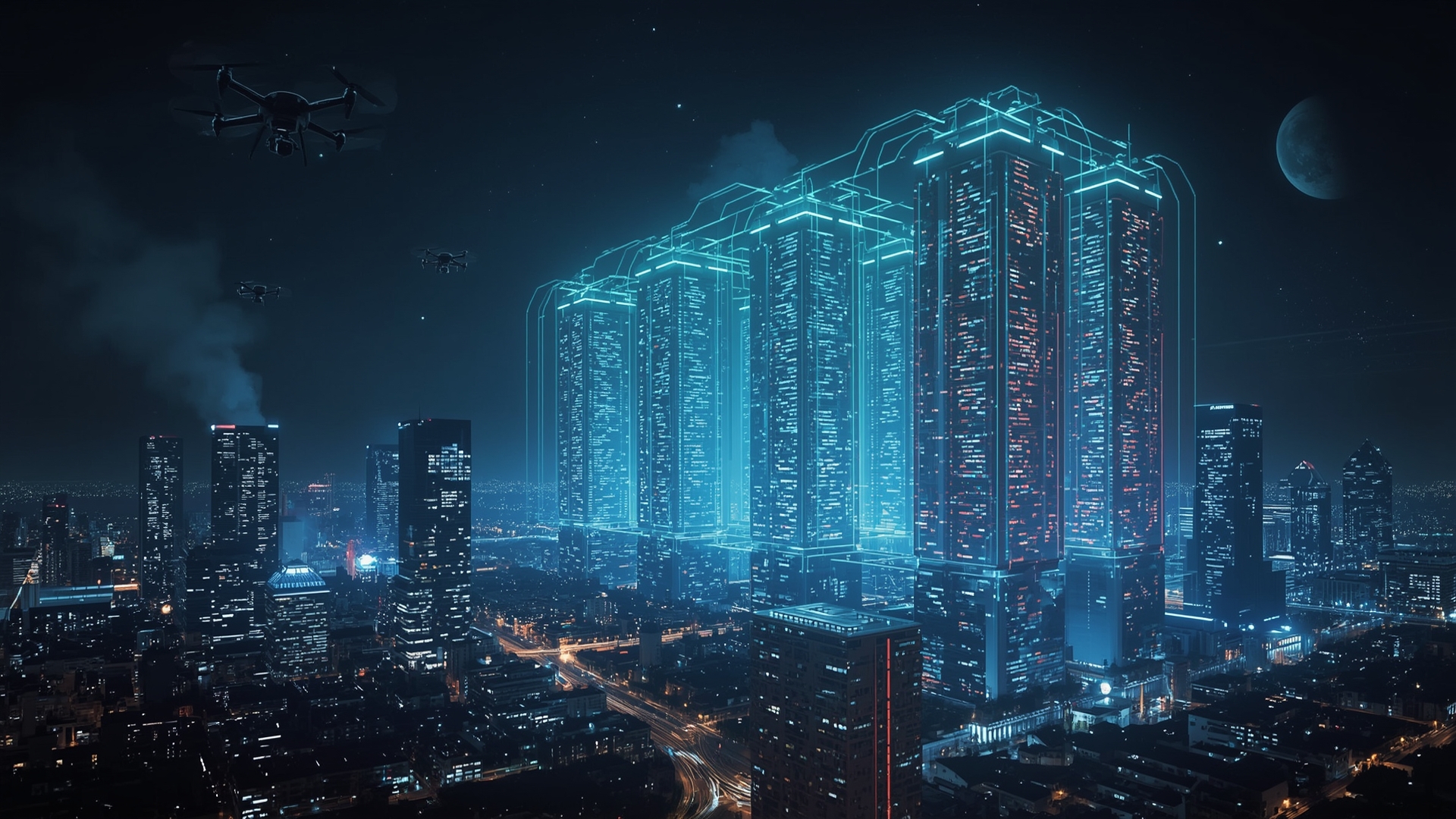
The Hidden Giants: Unveiling the Energy, Water, and Environmental Toll of Data Centers
Discover how data centers consume massive energy, water, and resources, their carbon footprint, and the innovative solutions driving a sustainable digital revolution.


Every click you make ripples through a hidden network of colossal facilities—data centers—that rival small nations in energy appetite. Behind the seamless flow of information lies a voracious infrastructure guzzling hundreds of terawatt-hours of electricity, billions of liters of water, and emitting millions of tons of CO₂ annually. As artificial intelligence and cloud computing surge, these giants threaten our planet’s delicate balance. Dive into their inner workings, the environmental cost they exact, and the pioneering solutions offering a glimmer of hope.
The Digital Backbone: Scale, Footprint, and Growth
Data centers house the servers powering cloud services, streaming, and AI. Today, global operational energy use is estimated between 300–380 TWh in 2023, nearly double the consumption of just a decade ago.
In the U.S. alone, they used 176 TWh (4.4% of total electricity) in 2023. By 2030, electricity demand could soar to 945 TWh, equivalent to Japan’s entire power draw. This explosive growth, driven by AI workloads and streaming services, demands urgent attention.
The Hidden Thirst: Water’s Critical Role
Cooling these machines demands staggering water supplies. Globally, data centers consumed ≈560 billion liters in 2023—enough to fill over 200,000 Olympic pools—and could rise to 1,200 billion liters by 2030. In Virginia’s “Data Centre Alley,” water use jumped to 1.85 billion gallons (≈7 billion liters) in 2023, stressing drought‑prone communities.
Every click you make ripples through a hidden network of colossal facilities—data centers—that rival small nations in energy appetite. Behind the seamless flow of information lies a voracious infrastructure guzzling hundreds of terawatt-hours of electricity, billions of liters of water, and emitting millions of tons of CO₂ annually. As artificial intelligence and cloud computing surge, these giants threaten our planet’s delicate balance. Dive into their inner workings, the environmental cost they exact, and the pioneering solutions offering a glimmer of hope.
The Digital Backbone: Scale, Footprint, and Growth
Data centers house the servers powering cloud services, streaming, and AI. Today, global operational energy use is estimated between 300–380 TWh in 2023, nearly double the consumption of just a decade ago.
In the U.S. alone, they used 176 TWh (4.4% of total electricity) in 2023. By 2030, electricity demand could soar to 945 TWh, equivalent to Japan’s entire power draw. This explosive growth, driven by AI workloads and streaming services, demands urgent attention.
Cooling the Giants: Air, Liquid, and Immersion
Traditional CRAC (Computer Room Air Conditioning) and CRAH (Air Handler) systems remain the backbone of most data centers, circulating refrigerated air to extract heat from hot aisles. Yet these behemoths can consume up to 40% of a facility’s total energy and require extensive ductwork, chillers, and pumping systems—driving high operational costs and bulky footprints. Their reliance on evaporative cooling towers also contributes to significant water withdrawal in drought‑prone regions.
Liquid Cooling technologies—especially direct‑to‑chip and rear‑door heat exchangers—address many of these shortcomings. In one Vertiv study, ramping up direct‑to‑chip cooling to 75% of IT load cut facility power by 18.1% and total data center power by 10.2%, slashing Scope 2 emissions by a similar margin. Moreover, liquid cooling can reduce water use by up to 91%, per Infosys analysis, by minimizing reliance on water-cooled chillers . Liquid‑cooled facilities have also reported 15% improvement in Thermal Usage Effectiveness (TUE) over air-cooled peers.
At the technological frontier lies Immersion Cooling, where servers are submerged in non‑conductive fluids that directly absorb heat. Single‑phase systems alone can lower cooling‑power consumption by 95%, cut server power draw by 10–20%, and achieve PUEs as low as 1.03–1.08.
Startups like Submer claim up to 50% energy savings, 99% water reduction, and 85% smaller footprints. Two‑phase variants even “boil off” heat at the chip surface, delivering 5–15% per‑server power cuts and enabling racks up to 250 kW of density. Despite higher upfront costs and design complexity, immersion cooling often pays back in 2–3 years, making it a compelling path to hyperscale efficiency.
Carbon Footprint: From PUE to CUE
Power Usage Effectiveness (PUE) remains the standard metric: total facility energy divided by IT equipment energy. Hyperscale leaders report:
AWS: Global PUE of 1.15 in 2023, with some sites hitting 1.04.
Google: Averages 1.10, best site 1.06.
Microsoft: Newest builds 1.12, portfolio average 1.18.
Yet PUE masks carbon intensity. Carbon Usage Effectiveness (CUE)—CO₂ emitted per kWh consumed—reveals that AI‑intensive data centers could drive the industry’s share of global emissions from 1.4% today to 3.2% by 2025 if unchecked. Lowering PUE must be coupled with decarbonized grids to truly shrink data centers’ carbon footprint.
Titans of the Cloud: Google, AWS, Microsoft
Google: Operating in 20+ regions, Google aims for net‑zero by 2030. Yet its true emissions may exceed disclosures—one report cites a 65% rise in actual emissions between 2019–24, totaling 14.3 MtCO₂e in 2023.
AWS: Pledges 100% renewable energy by 2025, but only 22% of data center power currently comes from green sources, per Amazon employees’ research.
Microsoft: Azure leverages cold‑climate sites, and Project Natick underwater pods harness ocean cooling; the company targets carbon negativity by 2030.
Beyond the Grid: Waste Heat, Edge, and Subsea Hubs
Visionary projects are repurposing data center waste heat:
Meta (Odense, Denmark): Supplies 100,000 MWh/year to heat 6,900 homes via district heating.
Equinix (Paris PA10): Exports 6.6 MW of thermal energy to the Olympic Aquatics Center, cutting 1,800 t CO₂ annually.
Apple (Viborg): Integrates cooling water into local district heating, powering 7 MWe heat pumps with CoP of 8.
Microsoft & Fortum (Helsinki): Pipes waste heat to 250,000 users across 900 km of infrastructure, the world’s largest heat‑reuse network.
Edge Computing complements these by distributing micro‑data centers closer to users, reducing transmission energy and latency. As on‑device AI grows, edge nodes will alleviate central load—shifting the sustainability equation.
By weaving advanced cooling, rigorous efficiency metrics, and regenerative heat reuse, the industry can transform data centers from environmental liabilities into pillars of a sustainable digital ecosystem. The key lies not only in innovative technology but in coupling it with transparent carbon accounting and bold regulatory frameworks.
Regulatory Landscape and the Road Ahead
Across Europe, data centers now fall under the Energy Efficiency Directive and Ecodesign Regulations, forcing operators to meet strict minimum efficiency thresholds and report detailed energy and water use to national regulators. The Digital Operational Resilience Act (DORA) will soon demand resilience tests and transparency on environmental risks, while the EU Taxonomy is channeling investment only into facilities that meet sustainability criteria. In parallel, the Climate Neutral Data Centre Pact—a voluntary alliance of hyperscalers—commits signatories to a PUE below 1.3, 75% water savings, and full circularity of IT equipment by 2030.
In the United States, state‑level measures range from California’s Title 24 green building standards—now encompassing server halls—to New York’s landmark climate law mandating public disclosure of data center carbon and water footprints. At the federal level, the Department of Energy is evaluating minimum performance standards for commercial servers and proposing incentives for waste‑heat reuse projects. Meanwhile, the FERC is examining grid‑friendly pricing models to reward data centers that shift loads away from peak demand.
Yet regulations alone cannot stem the tide of digital growth. Upcoming mandates on Scope 3 reporting will force data center customers—cloud consumers and enterprise tenants—to account for embedded emissions in hardware manufacture and supply chains. Binding water‑use caps in water‑stressed regions will compel closed‑loop or air‑based cooling adoption. And global carbon‑pricing mechanisms, now under discussion within the G20, could finally place a market cost on every kilowatt‑hour of fossil fuel–derived electricity powering the internet.
Voluntary pledges—like those in the Green Grid’s Sustainability Maturity Model or the ISO 30134 data center metrics standard—prove the industry’s appetite for self‑regulation, but unless these benchmarks become enforceable, they risk remaining marketing talking points rather than catalysts for genuine change.
Forging a Sustainable Digital Age
Our digital heartbeat pulses through these hidden giants—places of both astonishing innovation and immense resource demand. As the world becomes ever more dependent on instant access to AI, streaming, and cloud services, the true cost of convenience can no longer be ignored. Emerging regulations, from Europe’s toughest efficiency laws to U.S. water‑use caps, are lifting the veil on data centers’ environmental toll. But real transformation comes when each of us recognizes that every byte of data carries an ecological footprint.
Imagine a future where urban district heating warms homes with repurposed server heat, where underwater pods hum quietly in the deep, and where edge nodes in every city run on local solar and recycled water. That vision is within reach—but it demands that organizations design with circularity in mind, that investors value transparent carbon and water reporting, and that tech leaders break the habit of ever‑expanding, resource‑heavy builds.
In this pivotal moment, the choices we make—what services we stream, which cloud providers we trust, how we design the next generation of data infrastructure—will echo through the climate narrative of coming decades. The path ahead is as challenging as it is inspiring. By embracing rigorous efficiency, championing renewable energy, and weaving resource stewardship into every level of digital design, we can turn data centers from environmental liabilities into beacons of sustainable progress. The revolution starts now—beneath the surface of every click and every search lies both the problem and its solution.
